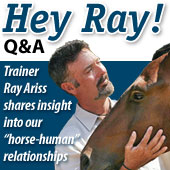 HEY RAY!: I always hear about how important it is to put your horse away on a good note. I understand why my horse didn’t improve (or got worse) when I put him away after a bad session. But, why didn’t my horse improve after I put him away on a good note?
HEY RAY!: I always hear about how important it is to put your horse away on a good note. I understand why my horse didn’t improve (or got worse) when I put him away after a bad session. But, why didn’t my horse improve after I put him away on a good note?
Lance Gunn
Norco, CA
HEY LANCE!: Your question is probably the single most important thing you should understand when trying to progress your horse. There are a lot of things you can do in order to train your horse, but nothing is more important than a clear picture.
The reason this is important is because it’s not the training session itself that solidifies your efforts. It’s the value the horse sees in what he is doing and the continuous thought that follows after he is put away that makes it stick. It is nothing more than a sale that you are pitching to your horse.
Imagine you are trying to sell something to someone you have just met, and you have only one shot to close the deal. Furthermore, closing is contingent on them sleeping on it before they commit. It is very much like that. You actually will not know how well you did with your horse until the next time you work with him. There’s a world of difference between having your horse do something right and having your horse “RECOGNIZE” that he did something right before putting him away.
The more you work with horses, the more you develop the ability and the judgment to recognize the subtleties of when a horse has accepted and recognized the value of your suggestions. There’s a look in a horse’s eye and in their body language that is obvious once you’ve seen it, and it screams “I got it!” I can’t tell you how many times I’ve worked with a horse on a specific exercise or challenge and successfully got him to work through it where that look in his eye that I’m talking about was absent. Putting him away at that point would be the same as never bringing him out for the training.
An even worse scenario just happened during a clinic I had this month. A gentleman named Jim brought me his Quarter Horse to work who had a phobia about going through the cowboy curtain. In other words, his horse had a preconceived notion about how he felt about the curtain as well as how things were going to turn out. I proceeded to prepare the horse by working on everything but the curtain. This gave me a chance to get a feel and an idea of how he felt about things in general, including how he felt about me.
We worked on sacking out, tying, flexing, as well as body control through lateral movement. All of this was done from the ground (in hand). This helped me to evaluate him in many ways and create a bit of history between us before asking him to consider taking the plunge into the scariest situation ever, according to Jim, his owner. Amazingly enough, only after a few refusals, Jim’s horse chose to walk through the curtain successfully. You could not imagine the surprise on Jim’s face when he saw his horse conquer his greatest fear. The entire clinic erupted into applause. I could have stopped at this point, stayed on schedule and moved on, but I didn’t see that look in his eye. What made this situation different from any other was that before the horse went through the curtain, he had the FEELING that the curtain was a bad idea. After going through the curtain, Jim’s horse was CERTAIN that not only was it a bad idea, but he was not going to do it again. At first glance, everything seemed fine to everyone, but if this horse was put away and then asked to repeat what we thought he had learned the day before, it would not have worked. Lance, there wouldn’t be much difference between what you have been experiencing with your horse and what probably Jim would have experienced if I hadn’t taken his horse through the curtain again. I had to continue the process until that look in his eye was present. For this horse, the ideal time to stop and put away was after he clearly accepted the curtain by going through it repeatedly.
Lance, I’m confident that if you pay close attention to the signs your horse gives you before you finish your sessions, progress will surely follow.
Remember to trust your instincts and think safe,
Ray
Horsetrader columnist Ray Ariss, husband to Pippa Ariss and father of six, shares his insight into the relationship of horse-and-human twice each month, in print and on www.horsetrader.com. He lives and trains in “Horsetown USA”, Norco CA, at his bustling StarBrite Riding Academy. Does your “horse-human” relationship leave you with a question for Ray? Just go to www.horsetrader.com and click on the “Hey Ray!” section, then submit it!
Leave a Comment
All fields must be filled in to leave a message.